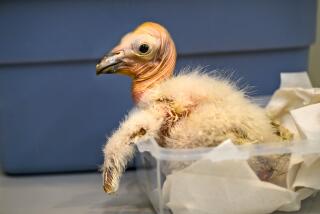1 of 4 Andean Condor Chicks Dies on Trip
- Share via
VENTURA — One of four baby female Andean condors died while being driven to remote mountain cliffs for an experiment that could lead to the return of California condors to the wild, officials said Saturday.
Two 4-month-old chicks born and raised at the San Diego Wild Animal Park were driven Friday night to the Los Angeles Zoo to rendezvous with another chick housed at the zoo and one born at the U.S. Fish and Wildlife Service’s Patuxent Wildlife Research Center in Laurel, Md.
After a drive of about 60 miles to the rugged Ventura County back country, biologists carried the birds during a final 90-minute, after-midnight hike to the study site along a “rather tortuous ridge trail,” said Joseph Dowhan, condor recovery coordinator for the Fish and Wildlife Service.
Taken to Sanctuary
The chicks were placed in a plywood box inside a larger net enclosure, where they will spend the next several months. They were taken to cliffs pocked by caves in the 60,000-acre Hopper Mountain National Wildlife Refuge, part of the Sespe Condor Sanctuary in the Los Padres National Forest, about 30 miles north of Ventura.
After loading the first three birds, the fourth chick was found dead about 2 a.m. Dowhan said the dead chick was born at the Dallas Zoo and had been kept at the Los Angeles Zoo.
“It’s unfortunate. It had seemed to be doing really well. . . . We have no idea on the cause” of death, Dowhan said. An autopsy will be performed at the San Diego Zoo.
The remaining three birds are doing well, he said, although one “seems rather quiet and intimidated by the others.”
“It really is regrettable that we’ve lost this bird. But the experiment is designed to smooth out the process so that when the time comes to release the highly endangered California condors, we will have worked out the problems and that will go smoothly,” Dowhan said.
Two Years in the Wild
The birds will be kept in the box and net enclosure for several months while being monitored by a team of biologists through one-way glass. They will be released when the youngest is able to fly, estimated to be in December. After two years of monitoring in the wild, the birds will be recaptured.
The experiment will allow biologists to evaluate techniques that could be used to re-establish a wild population of the nearly extinct California condor. Only 28 California condors remain in the world, all in zoos.
Andean condors, native to the mountains of South America, were chosen for the experiment because of their close similarity to their California cousins. Only females were chosen to prevent establishment of a permanent Andean condor population in California.
The release experiment is expected to cost at least $440,000.
More to Read
Sign up for Essential California
The most important California stories and recommendations in your inbox every morning.
You may occasionally receive promotional content from the Los Angeles Times.










